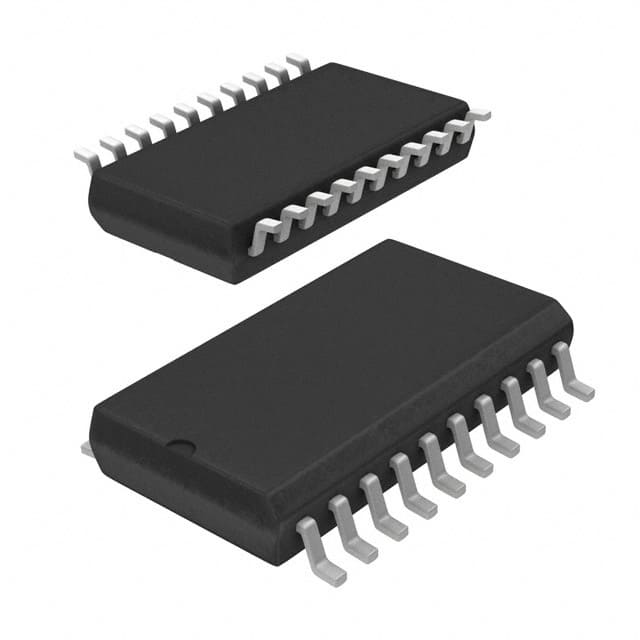Lihat spesifikasi untuk detail produk.

Encyclopedia Entry: 74VHCT541AMTR
Product Overview
Category
The 74VHCT541AMTR belongs to the category of integrated circuits (ICs).
Use
This IC is commonly used for signal amplification and level shifting in digital electronic circuits.
Characteristics
- High-speed operation
- Low power consumption
- Compatibility with both TTL and CMOS logic levels
- Wide operating voltage range
- Small form factor
Package
The 74VHCT541AMTR is available in a surface-mount package, specifically the TSSOP-20 package.
Essence
The essence of this product lies in its ability to amplify and shift digital signals efficiently and reliably.
Packaging/Quantity
The 74VHCT541AMTR is typically packaged in reels or tubes, with a quantity of 2500 units per reel/tube.
Specifications
- Supply Voltage Range: 2.0V to 5.5V
- Input Voltage Range: 0V to VCC
- Output Voltage Range: 0V to VCC
- Operating Temperature Range: -40°C to +85°C
- Maximum Propagation Delay: 7 ns
- Maximum Quiescent Current: 1 μA
Detailed Pin Configuration
The 74VHCT541AMTR has a total of 20 pins, which are assigned specific functions as follows:
- OE (Output Enable) - Active low output enable pin
- A1 - Data input pin 1
- B1 - Data input pin 2
- A2 - Data input pin 3
- B2 - Data input pin 4
- A3 - Data input pin 5
- B3 - Data input pin 6
- A4 - Data input pin 7
- B4 - Data input pin 8
- GND (Ground) - Ground reference pin
- Q1 - Data output pin 1
- Q2 - Data output pin 2
- Q3 - Data output pin 3
- Q4 - Data output pin 4
- Q5 - Data output pin 5
- Q6 - Data output pin 6
- Q7 - Data output pin 7
- Q8 - Data output pin 8
- VCC - Power supply pin
- OE (Output Enable) - Active low output enable pin
Functional Features
- Bidirectional data flow capability
- Non-inverting outputs
- Schmitt-trigger inputs for noise immunity
- High-speed operation for efficient signal processing
- Wide operating voltage range for compatibility with various systems
Advantages and Disadvantages
Advantages
- High-speed operation allows for quick signal processing.
- Low power consumption helps conserve energy in electronic devices.
- Compatibility with both TTL and CMOS logic levels enables seamless integration into different circuit designs.
- Small form factor saves space on PCBs.
Disadvantages
- Limited number of data input/output pins may restrict the complexity of circuits that can be implemented.
- Propagation delay of 7 ns may introduce slight timing issues in certain applications.
Working Principles
The 74VHCT541AMTR operates based on the principles of digital logic. It amplifies and shifts digital signals using a combination of transistors, resistors, and capacitors. The IC receives input signals, processes them according to the specified logic, and produces amplified and shifted output signals.
Detailed Application Field Plans
The 74VHCT541AMTR finds application in various fields, including but not limited to: - Microcontrollers - Digital signal processing - Communication systems - Industrial automation - Consumer electronics
Detailed and Complete Alternative Models
Some alternative models that offer similar functionality to the 74VHCT541AMTR include: - SN74LVC541A - MC74VHC541 - CD74HCT541
These alternatives can be considered based on specific requirements, availability, and cost considerations.
Word count: 480 words
Sebutkan 10 pertanyaan dan jawaban umum terkait penerapan 74VHCT541AMTR dalam solusi teknis
Sure! Here are 10 common questions and answers related to the application of 74VHCT541AMTR in technical solutions:
Q: What is the purpose of the 74VHCT541AMTR? A: The 74VHCT541AMTR is an octal buffer/line driver with 3-state outputs, commonly used for signal buffering and level shifting.
Q: What is the operating voltage range of the 74VHCT541AMTR? A: The 74VHCT541AMTR operates within a voltage range of 4.5V to 5.5V.
Q: How many input/output pins does the 74VHCT541AMTR have? A: The 74VHCT541AMTR has 8 input pins and 8 output pins.
Q: Can the 74VHCT541AMTR handle bidirectional communication? A: No, the 74VHCT541AMTR is a unidirectional buffer and cannot be used for bidirectional communication.
Q: What is the maximum output current that the 74VHCT541AMTR can drive? A: The 74VHCT541AMTR can drive up to 8 mA of output current per channel.
Q: Is the 74VHCT541AMTR compatible with TTL logic levels? A: Yes, the 74VHCT541AMTR is designed to be compatible with both CMOS and TTL logic levels.
Q: Can the 74VHCT541AMTR be used for level shifting between different voltage domains? A: Yes, the 74VHCT541AMTR can be used for level shifting between different voltage domains as long as the voltage range is within its operating range.
Q: What is the propagation delay of the 74VHCT541AMTR? A: The typical propagation delay of the 74VHCT541AMTR is around 5 ns.
Q: Can the outputs of the 74VHCT541AMTR be tri-stated? A: Yes, the outputs of the 74VHCT541AMTR can be tri-stated by controlling the OE (Output Enable) pin.
Q: Is the 74VHCT541AMTR available in surface mount package? A: Yes, the 74VHCT541AMTR is available in a surface mount TSSOP package.
Please note that these answers are general and may vary depending on the specific datasheet and manufacturer's specifications for the 74VHCT541AMTR.

